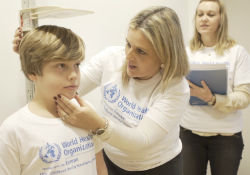About COSI

WHO
COSI was set up in response to the WHO European Ministerial Conference on Counteracting Obesity, held in Istanbul, Turkey, in 2006. Member States recognized the need for a harmonized surveillance system among primary school children to inform policy development in combating the emerging obesity epidemic in the WHO European Region. The importance of, and political commitment to, the surveillance system was reinforced in the Vienna Declaration on Nutrition and Noncommunicable Diseases in the Context of Health 2020, adopted in 2013, and the European Food and Nutrition Action Plan 2015–2020, adopted in 2014.
COSI is a survey based on nationally representative samples and takes standardized weight and height measurements and collects information on school environments and dietary and physical activity habits. The children are measured and studied on the basis of a common protocol and approach. The first data collection took place during the 2007–2008 school year, the second during the 2009–2010 school year, the third during the 2012–2013 school year and the fourth during the 2015–2016 school year. The fifth round is taking place during the 2018–2019 school year. COSI is now established in over 40 Member States of the Region, with the number of countries growing with each data collection round.
Since its launch in 2007, COSI has made a difference by informing policy initiatives and the public health response to the obesity epidemic in the Region. The COSI data collected over the past 10 years has also resulted in numerous international and country-specific scientific publications and reports.
COSI sign-up and data collection process
All countries in the Region are encouraged to sign up for COSI.
Prior to the introduction of COSI in a Member State, the country identifies an institute with responsibility for the overall national coordination and management and assigns a principal investigator as the institute’s authorized representative. The institute then signs a collaborative agreement with WHO/Europe, defining the roles and responsibilities of the participating country and of the Regional Office, including data release and publication policies, principles, terms and procedures.
The COSI system is simple to implement and does not consume many resources. It does not aim to replace the existing health, anthropometric and dietary surveillance systems of countries or those being planned. On the contrary, the COSI approach has a strong potential to be integrated into existing systems, where possible. The COSI protocol and manual of procedures allow each participating country to develop a system that fits its local circumstances.
WHO/Europe now offers a tool for online data collection in response to the growing number of countries participating in the initiative. This database management system, called OpenClinica, is custom prepared for interested countries to facilitate the process. Using this platform, data can be entered directly online during data collection or afterwards from the information collected on paper.
WHO/Europe provides technical support for the implementation of COSI, and a scientific development group is advising on the continuing improvement of the survey methods and tools. WHO/Europe also offers countries training and assistance in sampling, use of equipment, and the interpretation, presentation and use of data. WHO/Europe is working collaboratively with institutions across the Region to publish articles and reports using COSI data, and organizes COSI network meetings every year to facilitate support and collaboration with participating countries.
Survey methods
The COSI target group is the national population of primary school children aged 6–9 years. Once a nationally representative sample of primary schools has been selected with the introduction of the system, these schools may remain national sentinel sites where the same schools are used in following rounds. Alternatively, countries may opt to select a new nationally representative sample of schools at each COSI round.
COSI is implemented in accordance with international ethical guidelines. Parents are fully informed about all the study procedures, and their informed consent for the measurements and data treatment is obtained on a voluntary basis prior to the child’s enrolment in the system. Children’s consent is also obtained before the measurements. Information is collected on 2 mandatory forms (child and school) and 1 optional form (family).
The child form includes some mandatory variables such as weight, height, date of birth (or age) and sex, and some voluntary questions which the countries can choose to use or not. The anthropometric measurements are taken by examiners who are trained and standardized according to the common protocol. Similar to the child form, the school record form includes a few mandatory characteristics concerning the school environment, such as the frequency of physical education, the availability of school playgrounds, the possibility of purchasing a number of listed food items and beverages on the school premises, and current school initiatives to promote a healthy lifestyle. The voluntary family record form is completed by parents or caregivers and can provide data on children’s dietary intake, physical activity and inactivity patterns, as well as families’ socioeconomic characteristics and comorbidity conditions associated with obesity. Data are collected once in a given school year and rounds will be conducted every 2 or 3 years.
Each country is responsible for national data collection and analysis through the previously identified institute in charge of overall national coordination and management. Data are analysed both at national level and by the surveillance initiative investigators team at WHO/Europe, which conducts common cross-country analyses of the pooled dataset. The data management process will be complete with the release of the information through reports and/or scientific publications.
For detailed information on the survey methods, these documents outline the common protocol agreed for use in the initiative:





